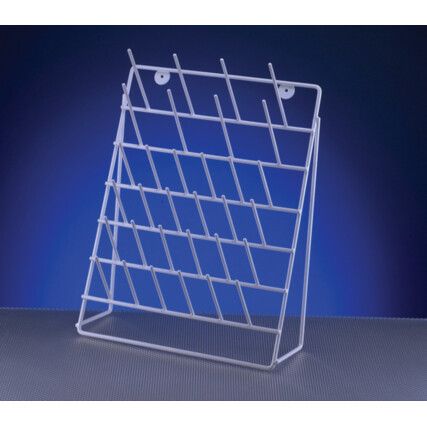Draining Rack
Shop for high-quality draining racks online now at Cromwell. Designed specifically to airdry laboratory glassware and other lab equipment, choose products from reliable brands, like Azlon®.
What is a draining rack?
Draining racks are used for drying laboratory glassware, like beakers, flasks, and test tubes. They're often made from wire and coated with chemical-resistant plastic to protect the containers against chips and scratches.
Why buy a draining rack?
Laboratory glassware can either be autoclaved (if suitable). Due to the shape of glassware, drying with a towel isn't always possible (or appropriate where there are risks of chemical residue), and so airdrying is the best option.
When are draining racks used?
Draining racks are often used in laboratories where the shape of the glassware makes drying via a tea towel or other cloth impossible; think test tubes and conical flasks where this task would prove difficult. They are also used in domestic settings aas well as industrial such as commercial kitchens.
Draining rack types
• Fixed peg design - This type of draining rack comes in a range of sizes which can be chosen according to requirements.
• Removable peg design - This adaptable design allows for pegs to be reconfigured to suit the size and type of glassware at any given time.
• Freestanding design - Suitable for standing on a worksurface or in a tray to collect drips, these designs are quick and easy to store and place when required.
• Wall-mounted design - These designs are sturdy and easy to install for a more permanent solution.
Considerations when choosing draining racks
• Equipment - the size and shape of the laboratory glassware you'll be using on a draining rack will help to inform your decision on the type to choose. If you have a wide range of shapes and sizes, a removable peg style might be the best option or one small and one large rack may be the solution.
• Space - often draining racks are situated near to where glassware is cleaned for safe transfer from one area to the next. Depending on the space you have, a wall-mounted option near a sink over a draining board is an efficient choice. However, if this isn't possible, freestanding designs can be stored and utilised when required.
Draining rack jargon buster
Lots of laboratory products feature plastics, so, we wanted to give a short and simple guide on the top three chemical-resistant plastics and their general characteristics...
What are the top chemical-resistant plastics?
• Polytetrafluorethylene (PTFE) - Heat resistant up to 260° and autoclavable up to 121°C, delivers high resistance to most lab chemicals.
• Polyvinyl chloride (PVC) - Heat resistant up to 70°C, but not suitable for autoclaving. Good resistance to water-based lab chemicals but shouldn't be used for organic solvents or anything stronger.
• High-density polyethylene (HDPE) - Heat resistant up to 120°C, but not suitable for autoclaving. Resists a range of lab chemicals, including acids.
FAQs
Can I dry laboratory glassware with a towel or hairdryer?
We wouldn't recommend using either of these techniques as they might introduce contaminants. The best way to dry laboratory glassware is airdrying on a rack.
Why is acetone used to clean laboratory glassware?
Acetone is an organic solvent which is miscible (mixes very well) with water. This is ideal when cleaning strength is required to remove chemicals using more than water alone.
